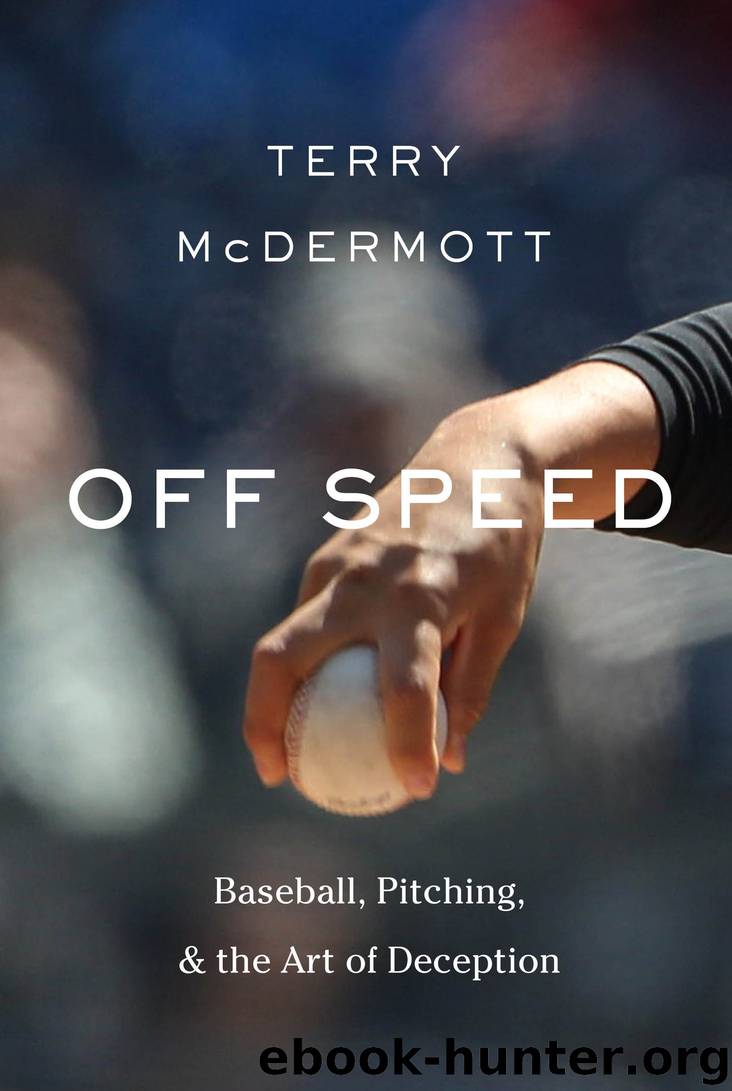Off Speed by Terry McDermott

Author:Terry McDermott
Language: eng
Format: epub
Publisher: Knopf Doubleday Publishing Group
Published: 2017-05-16T04:00:00+00:00
FASTBALL COMMAND
One of the conundrums pitchers who have developed good curveballs face—in part because umps are less likely to call strikes on curveballs, and in part because breaking balls are simply much harder to hit—is that hitters, if given a choice, virtually ignore everything but fastballs. As noted, no matter how hard a pitcher throws, major league hitters who sit looking for the fastball, and get it, will punish the pitch. Take you to the moon, as James Shields says.
So, if a pitcher is supposed to “establish his fastball,” and hitters are counting on him to do exactly this and donning their flight suits in preparation, what can a pitcher do? Young pitchers often just try to throw harder. They pay a high price for their ambition. Trying to throw harder invariably costs a pitcher his control. The result—consistently pitching behind in the count—is a ticket to a short career. Until they learn to spot their fastballs consistently, what can pitchers do?
One solution is to throw fastballs that don’t act like fastballs—that is, fastballs that move in directions other than those of the normal four-seam rising fastball. As pitchers learned from their experiments throwing various curveballs, the spin on the ball and its movement could be affected by the placement of their fingers on the ball, by the angle from which the ball is released, by the pressure they put on the ball with their fingers, and, last, by the snap of the wrist at release. If a pitcher wanted to get dramatic movement on a pitch, some significant amount of spin had to be applied to the ball by rolling the wrist in one direction or the other as the wrist snap occurred. That’s the essential motion for throwing any pitch, to make it move.
All pitchers have unique anatomy and employ slight to large variations in pitching mechanics. This is reflected in the pitches they throw. In the earlier days of modern baseball, pitchers regarded their fastballs as nature’s gift, as Bill James puts it. If the ball moved up, in, out, or in any other peculiar fashion, so much the better.
Eventually, pitchers applied the lessons learned from throwing curves to the fastball. Simply put, they learned they could make their fastballs move. James cites Curt Simmons, a left-hander who had a long and successful National League career beginning in the 1940s, as the first pitcher to throw both a rising and a sinking fastball on purpose. It has become common since. In the 1960s and ’70s, Fergie Jenkins of the Cubs and Tom Seaver, mainly with the Mets, pitched their ways into the Hall of Fame with fastball variety.
Hitting is expectation and habituation. Pitching is surprise and interruption. The most common way to throw a fastball that moves contrary to expectation is to throw one that sinks.
The general method for throwing a sinking fastball is to grip the ball with the index and middle fingers aligned along the seams of the ball. Because of the grip, the pitch is often called a two-seamer.
Download
This site does not store any files on its server. We only index and link to content provided by other sites. Please contact the content providers to delete copyright contents if any and email us, we'll remove relevant links or contents immediately.
Machine Learning at Scale with H2O by Gregory Keys | David Whiting(4200)
Never by Ken Follett(3801)
Liar's Poker by Michael Lewis(3372)
The Ultimate Backcountry Survival Manual by Aram Von Benedikt; Editors of Outdoor Life;(3234)
Will by Will Smith(2796)
The Partner by John Grisham(2350)
Can't Hurt Me: Master Your Mind and Defy the Odds - Clean Edition by David Goggins(2230)
Friends, Lovers, and the Big Terrible Thing by Matthew Perry(2126)
Taste by Kris Bryant(1840)
HBR's 10 Must Reads 2022 by Harvard Business Review(1782)
A Short History of War by Jeremy Black(1764)
Never Finished: Unshackle Your Mind and Win the War Within by David Goggins(1648)
515945210 by Unknown(1602)
A Game of Thrones (The Illustrated Edition) by George R. R. Martin(1596)
The Arm by Jeff Passan(1578)
The Dodgers by Schiavone Michael;(1517)
The Yogi Book by Yogi Berra(1478)
443319537 by Unknown(1472)
Why We Love Baseball by Joe Posnanski(1445)
